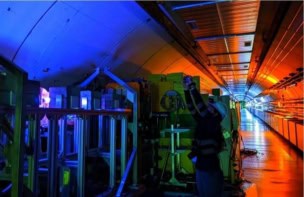
Physicists have been given the first glimpse of nuclear excitation by electron capture (NEEC), confirming theoretical predictions that were made more than 40 years ago. The global team – led by Jeff Carroll and Christopher Chiara of the US Army Research Laboratory in Adelphi, Maryland – excited an atomic nucleus by causing it to absorb an electron and confirmed its excited state by observing the subsequent pattern of nuclear decay. Their work could lead to the development of new energy-storage systems and could also explain the abundances of elements such as gold and platinum in the universe.
We often think of atomic electrons orbiting some distance away from the nucleus, but some inner-shell electrons have a finite probability of being inside the nucleus. Through a well known decay process known as “internal conversion”, for example, an atomic nucleus can decay by transferring energy to such an electron – causing it to be ejected from the atom.
No easy feat
NEEC is essentially the reverse of internal conversion, and some physicists have been advocating its existence for several decades. The process begins with the absorption of a free electron by a hole in a normally filled atomic shell. If the electron’s initial kinetic energy plus its atomic binding energy matches the energy difference between two nuclear states, then nuclear excitation can occur. While straightforward in theory, this energy-matching requirement makes NEEC no easy feat to pull off experimentally.
To make their observations, the team produced atoms of the radioactive isotope molybdenum-93 and had them absorb electrons of energy that they believed would cause NEEC. They predicted that if the nucleus did become excited, its sequence of decay products would be different to that of an unexcited nucleus. Determining the decay sequence involved analysing gamma-ray emissions from decay products with differing half-lives. As hoped, their measurements matched up with the theoretical predictions of the unique decay sequence of an excited molybdenum-93 nucleus.

Elusive nuclear-clock transition spotted in thorium-229
One important consequence of the discovery is that it provides a possible explanation for the abundance of elements such as gold and platinum in the universe. If NEEC were a fairly common process in nature, then certain elements could transform into others after being created in stars. The team’s work could also lead to the development of new technologies that harness the energy of excited nuclei. This, according to Carroll, could lead to power sources with an energy density 100,000 times greater than that in chemical batteries.
The research is described in Nature.



